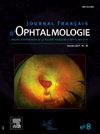Comparative efficacy of subthreshold micropulse laser therapy for chronic central serous chorioretinopathy: Navigated vs. non-navigated approach
IF 1.2
4区 医学
Q3 OPHTHALMOLOGY
引用次数: 0
Abstract
Purpose
To evaluate the efficacy of navigated subthreshold micropulse laser (NSML) compared to subthreshold micropulse laser (SML) without navigation in the management of chronic central serous chorioretinopathy (CSCR).
Materials and methods
This retrospective study included patients diagnosed with chronic CSCR who underwent either NSML or SML without navigation. Patients meeting inclusion criteria presented with serous macular detachment and leakage at the level of the retinal pigment epithelium on fundus fluorescein angiography (FFA). The NSML group underwent treatment using the Navilas® Laser System 577s Prime, operating at a wavelength of 577 nanometers. Micropulse laser application targeted the leakage areas identified on mid-phase FFA images, which were imported into the laser device and aligned with the live image using an eye tracking system. The SML without navigation group underwent treatment using the 577-nanometer yellow laser, delivered through the area centralis laser lens. Laser therapy was guided by focal leaking points and areas of hyperpermeability identified on FFA.
Results
A total of 34 patients underwent NSML, while 36 patients received SML without navigation. Both groups were similar in terms of demographic and clinical characteristics. No statistically significant difference was found in visual and anatomical outcomes between the NSML and SML groups at 1 and 3 months post-treatment (P > 0.05). However, favorable outcomes were observed in both groups, with a cumulative probability of successful treatment reaching 73.5% in the NSML group and 63.8% in the SML group. Notably, no adverse events were reported in either group.
Conclusion
Both NSML and SML without navigation demonstrate efficacy and safety in treating CSCR, with improvements in visual and anatomical outcomes observed during the 3-month follow-up period. NSML emerges as a promising treatment option for facilitating the resolution of subretinal fluid in patients with chronic CSCR.
Contexte
Évaluer l’efficacité du laser à micropulsations sous-seuil avec navigation (LMSN) par rapport au laser à micropulsations sous-seuil (SML) sans navigation dans la prise en charge de la choriorétinopathie séreuse centrale chronique (CSCR).
Matériel et méthodes
Cette étude rétrospective a inclus des patients diagnostiqués avec une choriorétinopathie centrale séreuse chronique qui ont subi soit un LMSN, soit un SML sans navigation. Les patients répondant aux critères d’inclusion présentaient un décollement maculaire séreux et une fuite au niveau de l’épithélium pigmentaire rétinien à l’angiographie à la fluorescéine du fond d’œil (AFF). Le groupe LMSN a été traité à l’aide du Navilas® Laser System 577s Prime, fonctionnant à une longueur d’onde de 577 nanomètres. L’application du laser à micropulsations a ciblé les zones de fuite identifiées sur les images AFF à mi-phase, qui ont été importées dans le dispositif laser et alignées sur l’image en direct à l’aide d’un système de suivi oculaire. Le groupe SML sans navigation a été traité à l’aide du laser jaune de 577 nanomètres, délivré à travers la lentille laser Area Centralis. La thérapie au laser a été guidée par les points de fuite focaux et les zones d’hyperperméabilité identifiées sur la AFF.
Résultats
Au total, 34 patients ont bénéficié d’une LMSN, tandis que 36 patients ont reçu une SML sans navigation. Les deux groupes étaient similaires en termes de caractéristiques démographiques et cliniques. Aucune différence statistiquement significative n’a été trouvée dans les résultats visuels et anatomiques entre les groupes LMSN et SML à 1 et 3 mois après le traitement (p > 0,05). Cependant, des résultats favorables ont été observés dans les deux groupes, avec une probabilité cumulée de traitement réussi atteignant 73,5 % dans le groupe LMSN et 63,8 % dans le groupe SML. Notamment, aucun événement indésirable n’a été rapporté dans l’un ou l’autre groupe.
Conclusion
Le LMSN et le SML sans navigation ont tous deux démontré leur efficacité et leur sécurité dans le traitement du CSCR, avec des améliorations des résultats visuels et anatomiques observées au cours de la période de suivi de 3 mois. Le LMSN apparaît comme une option thérapeutique prometteuse pour faciliter la résolution du liquide sous-rétinien chez les patients atteints de CSCR chronique.
阈下微脉冲激光治疗慢性中枢性浆液性脉络膜视网膜病变的比较疗效:导航与非导航入路
目的评价导航阈下微脉冲激光(NSML)与无导航阈下微脉冲激光(SML)治疗慢性中枢性浆液性脉络膜视网膜病变(CSCR)的疗效。材料和方法本回顾性研究包括诊断为慢性CSCR的患者,他们接受了NSML或无导航的SML。符合纳入标准的患者在眼底荧光素血管造影(FFA)上表现为浆液性黄斑脱离和视网膜色素上皮水平渗漏。NSML组使用Navilas®激光系统57s Prime进行治疗,工作波长为577纳米。微脉冲激光应用于中期FFA图像上识别的泄漏区域,这些图像被导入激光设备,并使用眼动追踪系统与实时图像对齐。没有导航的SML组使用577纳米黄色激光,通过中央区域激光透镜进行治疗。激光治疗以FFA上确定的病灶渗漏点和高渗区为指导。结果34例患者行无导航SML, 36例患者行无导航SML。两组在人口学和临床特征方面相似。NSML组和SML组在治疗后1个月和3个月的视觉和解剖结果无统计学差异(P >;0.05)。然而,两组均观察到良好的结果,NSML组和SML组的累计成功治疗概率分别达到73.5%和63.8%。值得注意的是,两组均未报告不良事件。结论NSML和无导航SML治疗CSCR均具有疗效和安全性,随访3个月,视觉和解剖结果均有改善。NSML作为促进慢性CSCR患者视网膜下液溶解的一种有希望的治疗选择。ContexteÉvaluer激光微脉冲ssseail导航(LMSN)与激光微脉冲ssseail无导航(SML)的关系是激光微脉冲ssseail无导航(CSCR)的关系。物资等methodesCette练习曲回顾包括des病人diagnostiques用一个chorioretinopathie舟状骨sereuse chronique校正subi所以联合国LMSN,所以联合国SML无导航。3例患者有下列症状:1例患者有下列症状:1例患者有下列症状:1例患者有下列症状:1例患者有下列症状:1例患者有下列症状:1例患者有下列症状:1例患者有下列症状:1例患者有下列症状:1例患者有下列症状:1例患者有下列症状:1例患者有下列症状:1例患者有下列症状:1例患者有下列症状:1例患者有下列症状:1例患者有下列症状:1例患者有下列症状:1例患者有下列症状:Le groupe LMSN是一款基于Navilas®激光系统577s Prime的便携式便携式激光系统。应用激光微脉冲和光学脉冲区,可以有效地识别出 半相、 半相、 半相、 半相、 半相、 半相、 系统/系统/ 系统/系统/图像。Le groupe SML sans navigation a sametest trait l 'aide du laser jaune de 577 nanomres, dsametest travers la lentile laser Area Centralis。用激光和激光制导的方法,将激光和激光制导的方法,将激光和激光制导的方法,将激光和激光制导的方法,将激光和激光制导的方法,将激光和激光制导的方法,将激光和激光制导的方法,在激光和激光制导的方法中,将激光和激光制导的方法,在激光和激光制导的方法中,将激光和激光制导的方法,在激光和激光制导的方法中,将激光和激光制导的方法,在激光和激光制导的方法中,将激光和激光制导的方法结合起来。这两个组是类似的,例如,两个组是相同的。有意义的;有统计学意义的;有统计学意义的;有统计学意义的;有统计学意义的;0 05)。在此基础上,与其他两组相比,其他两组相比,其他三组相比,其他两组相比,其他三组相比,其他三组相比,其他三组相比,其他三组相比,其他三组相比,其他三组相比,其他三组相比,其他三组相比,也更有优势。注:请注意,所有的 和/或所有的 /或所有的/或所有的/或所有的/或所有的/或所有的。ConclusionLe LMSN le SML无导航等他们全部的两个demontre efficacite等他们安全炸药在traitement du CSCR,用des经验结果visuels et anatomiques观察分为de la里面de suivi德3月。LMSN装置提供了一种选择,即:将患者的慢性CSCR患者的慢性CSCR患者的慢性CSCR患者的慢性CSCR患者的慢性CSCR患者的慢性CSCR患者的慢性CSCR患者的慢性CSCR患者的慢性CSCR患者的慢性CSCR患者的慢性CSCR患者的慢性CSCR患者的慢性CSCR患者的慢性CSCR患者的慢性CSCR患者的慢性CSCR。
本文章由计算机程序翻译,如有差异,请以英文原文为准。
求助全文
约1分钟内获得全文
求助全文
来源期刊
CiteScore
1.10
自引率
8.30%
发文量
317
审稿时长
49 days
期刊介绍:
The Journal français d''ophtalmologie, official publication of the French Society of Ophthalmology, serves the French Speaking Community by publishing excellent research articles, communications of the French Society of Ophthalmology, in-depth reviews, position papers, letters received by the editor and a rich image bank in each issue. The scientific quality is guaranteed through unbiased peer-review, and the journal is member of the Committee of Publication Ethics (COPE). The editors strongly discourage editorial misconduct and in particular if duplicative text from published sources is identified without proper citation, the submission will not be considered for peer review and returned to the authors or immediately rejected.

 求助内容:
求助内容: 应助结果提醒方式:
应助结果提醒方式:


